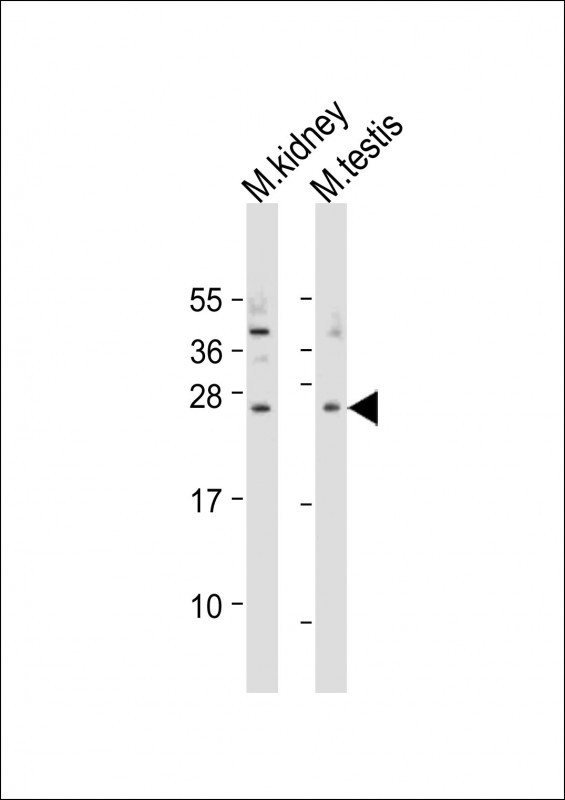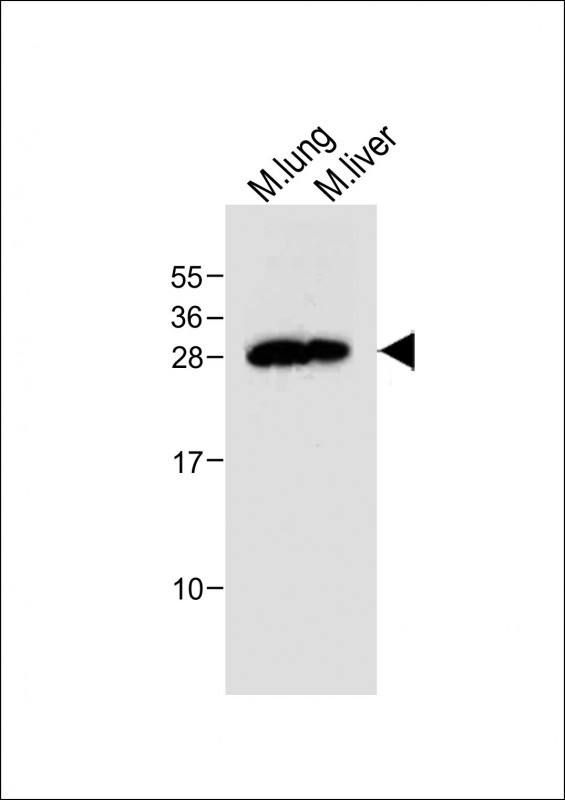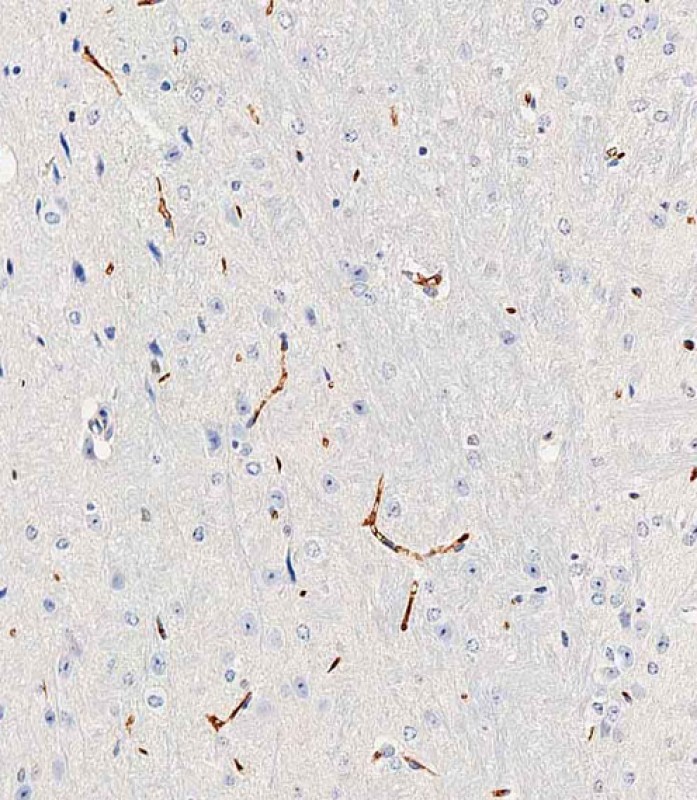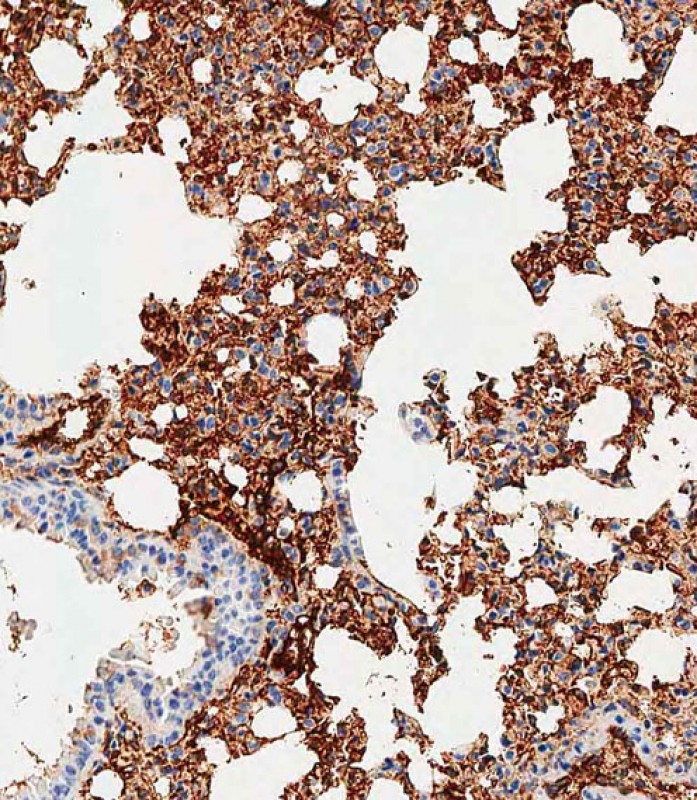Mouse Trem2 Antibody (N-term)
Affinity Purified Rabbit Polyclonal Antibody (Pab)
- SPECIFICATION
- CITATIONS
- PROTOCOLS
- BACKGROUND

Application
| IHC-P-Leica, WB, E |
|---|---|
| Primary Accession | Q99NH8 |
| Other Accession | NP_112544.1 |
| Reactivity | Mouse |
| Host | Rabbit |
| Clonality | Polyclonal |
| Isotype | Rabbit IgG |
| Calculated MW | 24527 Da |
| Antigen Region | 22-48 aa |
| Gene ID | 83433 |
|---|---|
| Other Names | Triggering receptor expressed on myeloid cells 2, TREM-2, Triggering receptor expressed on monocytes 2, Trem2, Trem2a, Trem2b, Trem2c |
| Target/Specificity | This Mouse Trem2 antibody is generated from rabbits immunized with a KLH conjugated synthetic peptide between 22-48 amino acids from the N-terminal region of mouse Trem2. |
| Dilution | IHC-P-Leica~~1:500 WB~~1:500 E~~Use at an assay dependent concentration. |
| Format | Purified polyclonal antibody supplied in PBS with 0.09% (W/V) sodium azide. This antibody is purified through a protein A column, followed by peptide affinity purification. |
| Storage | Maintain refrigerated at 2-8°C for up to 2 weeks. For long term storage store at -20°C in small aliquots to prevent freeze-thaw cycles. |
| Precautions | Mouse Trem2 Antibody (N-term) is for research use only and not for use in diagnostic or therapeutic procedures. |
| Name | Trem2 |
|---|---|
| Synonyms | Trem2a, Trem2b, Trem2c |
| Function | Forms a receptor signaling complex with TYROBP which mediates signaling and cell activation following ligand binding (PubMed:11241283). Acts as a receptor for amyloid-beta protein 42, a cleavage product of the amyloid-beta precursor protein APP, and mediates its uptake and degradation by microglia (PubMed:27477018, PubMed:29518356). Binding to amyloid-beta 42 mediates microglial activation, proliferation, migration, apoptosis and expression of pro- inflammatory cytokines, such as IL6R and CCL3, and the anti- inflammatory cytokine ARG1 (PubMed:27477018, PubMed:29518356). Acts as a receptor for lipoprotein particles such as LDL, VLDL, and HDL and for apolipoproteins such as APOA1, APOA2, APOB, APOE, APOE2, APOE3, APOE4, and CLU and enhances their uptake in microglia (PubMed:27477018). Binds phospholipids (preferably anionic lipids) such as phosphatidylserine, phosphatidylethanolamine, phosphatidylglycerol and sphingomyelin (By similarity). Regulates microglial proliferation by acting as an upstream regulator of the Wnt/beta-catenin signaling cascade (PubMed:28077724). Required for microglial phagocytosis of apoptotic neurons (PubMed:24990881). Also required for microglial activation and phagocytosis of myelin debris after neuronal injury and of neuronal synapses during synapse elimination in the developing brain (PubMed:15728241, PubMed:25631124, PubMed:28592261, PubMed:29752066). Regulates microglial chemotaxis and process outgrowth, and also the microglial response to oxidative stress and lipopolysaccharide (PubMed:28483841, PubMed:29663649, PubMed:29859094, PubMed:30232263). It suppresses PI3K and NF-kappa-B signaling in response to lipopolysaccharide; thus promoting phagocytosis, suppressing pro- inflammatory cytokine and nitric oxide production, inhibiting apoptosis and increasing expression of IL10 and TGFB (PubMed:29663649). During oxidative stress, it promotes anti-apoptotic NF-kappa-B signaling and ERK signaling (PubMed:28592261). Plays a role in microglial MTOR activation and metabolism (PubMed:28802038). Regulates age-related changes in microglial numbers (PubMed:25631124, PubMed:29752066, PubMed:30548312). Triggers activation of the immune responses in macrophages and dendritic cells. Mediates cytokine-induced formation of multinucleated giant cells which are formed by the fusion of macrophages (PubMed:18957693). In dendritic cells, receptor of SEMA6D with PLEXNA1 as coreceptor and mediates up-regulation of chemokine receptor CCR7 and dendritic cell maturation and survival (PubMed:16715077). Involved in the positive regulation of osteoclast differentiation (PubMed:16418779). |
| Cellular Location | [Isoform 1]: Cell membrane; Single-pass type I membrane protein |
| Tissue Location | Expressed in the brain, specifically in microglia (at protein level) (PubMed:15728241, PubMed:27477018, PubMed:28077724, PubMed:28559417, PubMed:28592261, PubMed:28802038, PubMed:28855301, PubMed:29752066, PubMed:29794134). Expressed in macrophages (at protein level) (PubMed:11241283, PubMed:28559417, PubMed:28802038). Expressed at higher levels in the CNS, heart and lung than in lymph nodes or in other non-lymphoid tissues such as kidney, liver and testis (PubMed:12472885). In the CNS not all microglia express TREM2 (PubMed:12472885). Brain regions with an incomplete blood-brain barrier had the lowest percentages of TREM2 expressing microglia, whereas the lateral entorhinal and cingulate cortex had the highest percentages (PubMed:12472885). |

Thousands of laboratories across the world have published research that depended on the performance of antibodies from Abcepta to advance their research. Check out links to articles that cite our products in major peer-reviewed journals, organized by research category.
info@abcepta.com, and receive a free "I Love Antibodies" mug.
Provided below are standard protocols that you may find useful for product applications.
Background
Trem2 may have a role in chronic inflammations and may stimulate production of constitutive rather than inflammatory chemokines and cytokines. Forms a receptor signaling complex with TYROBP and triggers activation of the immune responses in macrophages and dendritic cells.
References
Koth, L.L., et al. J. Immunol. 184(11):6522-6528(2010)
Whittaker, G.C., et al. J. Biol. Chem. 285(5):2976-2985(2010)
Peng, Q., et al. Sci Signal 3 (122), RA38 (2010) :
Chang, J.H., et al. Biochem. Biophys. Res. Commun. 389(1):28-33(2009)
Hsieh, C.L., et al. J. Neurochem. 109(4):1144-1156(2009)
If you have used an Abcepta product and would like to share how it has performed, please click on the "Submit Review" button and provide the requested information. Our staff will examine and post your review and contact you if needed.
If you have any additional inquiries please email technical services at tech@abcepta.com.













 Foundational characteristics of cancer include proliferation, angiogenesis, migration, evasion of apoptosis, and cellular immortality. Find key markers for these cellular processes and antibodies to detect them.
Foundational characteristics of cancer include proliferation, angiogenesis, migration, evasion of apoptosis, and cellular immortality. Find key markers for these cellular processes and antibodies to detect them. The SUMOplot™ Analysis Program predicts and scores sumoylation sites in your protein. SUMOylation is a post-translational modification involved in various cellular processes, such as nuclear-cytosolic transport, transcriptional regulation, apoptosis, protein stability, response to stress, and progression through the cell cycle.
The SUMOplot™ Analysis Program predicts and scores sumoylation sites in your protein. SUMOylation is a post-translational modification involved in various cellular processes, such as nuclear-cytosolic transport, transcriptional regulation, apoptosis, protein stability, response to stress, and progression through the cell cycle. The Autophagy Receptor Motif Plotter predicts and scores autophagy receptor binding sites in your protein. Identifying proteins connected to this pathway is critical to understanding the role of autophagy in physiological as well as pathological processes such as development, differentiation, neurodegenerative diseases, stress, infection, and cancer.
The Autophagy Receptor Motif Plotter predicts and scores autophagy receptor binding sites in your protein. Identifying proteins connected to this pathway is critical to understanding the role of autophagy in physiological as well as pathological processes such as development, differentiation, neurodegenerative diseases, stress, infection, and cancer.





